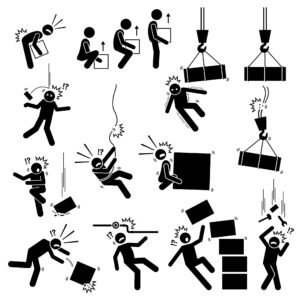After suffering injuries as the result of a ladder accident at work, you might be interested in finding out more about making a work injury claim. In this guide, we will discuss the accident at work process and the duty of care that employers owe their employees.

Ladder Accident Claims Guide
Furthermore, we will look at how a breach in this duty of care could cause an accident that results in injuries. We’ll also take a look at the factors that affect how much a claim could be worth and the process that goes into valuing claims. Finally, we will take a look at No Win No Fee agreements and how they can benefit claimants looking to pursue compensation with legal representation.
If you wish to find out if you could be eligible to pursue a ladder accident at work claim, then please get in touch to speak to an advisor. If you do have a valid claim, you could be connected to our expert panel of personal injury solicitors.
- Call us using the button at the top
- Send a message to an advisor via our online chat
- Complete our contact form
When Are You Eligible To Claim For A Ladder Accident At Work?
You may be able to pursue a ladder accident at work claim if you can prove that your injuries are a result of your employer breaching the duty of care that they owe you. All employers are legally required to adhere to The Health And Safety etc. Act 1974. The legislation states that employers should take reasonable and practicable steps to ensure the health and safety of their employees.
In order for you to make an accident at work claim, it’s essential that you meet the following eligibility criteria:
- You were owed a duty of care by an employer at the time and place of the accident
- This duty of care was breached
- You were involved in an accident as a result of the breach, resulting in injuries
If you would like more information on making a ladder accident at work claim, please don’t hesitate to contact us. If your claim is valid, you could be connected with a No Win No Fee solicitor from our panel.
Examples Of How A Ladder Accident Could Be Caused By Employer Negligence
Working at a height can pose certain hazards. Below we have included some examples of how ladder accidents at work can occur and the impact they could have:
- Your employer fails to clear debris from an area where you’re expected to work on a ladder, and this causes the base of the ladder to be unsteady as it can’t grip the floor. As a result, it falls over while you’re on it. You could be left suffering from a back injury and a neck injury from falling from a height.
- You use a ladder with a loose rung that your employer is aware of but has not fixed. Therefore, you fall to the ground, and the ladders fall on top of you, causing a broken rib and a shoulder injury
- You have not been adequately trained on how to use a ladder safely. As a result, you set the ladder up in a way that means it isn’t properly supported, causing you to fall and sustain a spinal injury.
Call us now to discuss whether you could have a valid claim. If you do, one of our advisors could connect you with a No Win No Fee lawyer from our panel.
Is There A Ladder Accident Claim Time Limit?
The Limitation Act 1980 states that the standard time limit for an accident at work claim is generally three years after the incident occurred. However, there are some exceptions:
- Reduced mental capacity – If someone lacks the mental capacity to pursue a claim, a litigation friend could do so for them. This is someone who will act in the best interests of the claimant, for example, a parent or a family friend. While the injured party can’t make their own claim, the time limit is suspended. It only resumes in the event that they become mentally capable of doing so.
- Under eighteen – If the injured party is under eighteen, the time limit will be suspended while they’re underage, and a litigation friend can claim on their behalf. While the child is underage, the time limit is suspended. If the child turns 18 with no claim having been made, they have 3 years in which to do this themselves.
If you have further questions about any part of the work injury claims process, speak with an advisor from our team today.
Potential Evidence When Making A Claim For A Work Injury
In preparation of making a ladder accident at work claim, you may wish to gather evidence. This can help prove that you were harmed as a result of your employer’s negligence.
Below, we’ve included examples of evidence that should be obtained that may help your claim:
- CCTV footage that captured the incident on camera
- Photographs of the injury and the accident site
- A report from the workplace accident book
- Medical records, such as X-rays, to highlight the ways you’ve been affected
- A diary of your symptoms, treatments you are receiving and how your quality of life has been affected by the injuries you sustained
Please be aware that this is just a guideline list. Not all of these forms of evidence will be applicable in every case. If you require help gathering evidence, then please give us a call and speak to one of our advisors. You could be connected with an accident at work solicitor who could help you collate evidence.
What Compensation Could Be Received From An Accident At Work Claim?
General damages are always awarded when an accident at work claim is successful. This head of claim compensates for the pain and suffering that you’ve experienced as a result of your injury. The severity of your injuries and the impact that they’ve had on your quality of life are all taken into account when calculating your compensation.
Legal professionals refer to the Judicial College Guidelines (JCG) when valuing this head of claim. The JCG is a publication which offers a list of injuries with their guideline compensation guideline brackets based on severity.
Below, we have included a table of injury brackets from the JCG. Remember, these figures are only a guideline, not a guarantee.
Compensation Table
| Injury | Value | Severity and Information |
|---|---|---|
| Injury from Brain Damage | £282,010 to £403,990 | Very Severe. Little or no language function and requirement for round-the-clock care. |
| £2,210 to £12,770 | Minor. Very minimal brain damage, if any at all. | |
| Eye Injury | £49,270 to £54,830 | Complete loss of sight in one eye where there is some risk of sympathetic opthalmia. |
| £3,950 to £8,730 | Minor. Initial pain and vision interference. | |
| Hip Injury | £39,170 to £52,500 | Severe (iii). Could include a leg fracture resulting in leg instability that will likely necessitate a hip replacement in the future. |
| £3,950 to £12,590 | Lesser Injuries (i) . Little or no residual disability. | |
| Hand Injury | £29,000 to £61,910 | Serious. Hand functions at around 50% capacity. For example, several fingers have been amputated and rejoined. |
| £5,720 to £13,280 | Moderate, Crush injuries and penetrating wounds, for example. | |
| Shoulder Injury | £19,200 to £48,030 | Severe. Significant disability as a result of injuries associated with neck injuries. |
| Up to £2,450 | Minor (iii). Full recovery within three months |
Special Damages In A Ladder Accident Claim
Special damages are compensation for past or future financial losses. These losses may cover expenses such as transport costs to hospital appointments, care costs and loss of earnings.
It’s important to keep evidence of these costs in order to try and claim them back. For example, if you broke your hand in a ladder accident and were off work for three weeks, a payslip could be used to outline your loss of earnings. Furthermore, if you had to get a taxi to a hospital appointment as a result of your workplace accident, you could keep the receipt if you wish to claim back the cost.
For more information, contact us today. Our advisors can offer free advice about the kinds of damages that could be included in a successful claim.
Use Our Panel Of Experienced No Win No Fee Solicitors To Make A Claim
No Win No Fee solicitors working under Conditional Fee Agreements can allow their employees to access their services without paying upfront fees. This kind of agreement also means:
- No ongoing fees to pay
- If the case fails, there is nothing to pay your lawyer for the work they have done
- A legally-limited percentage of your settlement, otherwise known as a success fee, is deducted from your settlement in the event that your claim is a success
Our expert No Win No Fee solicitors are here to support you through the claims process. If you would like to see if you could claim after being injured in a ladder accident at work, speak to one of our advisors today.
- Call us using the button at the top
- Send a message to an advisor via our online chat
- Complete our contact form
Learn More About Potential Accident Claim Payout Amounts
Below, you will find links to more of our guides:
How Do I Make A Claim For An Injury At Work
A Guide to Claiming For A Trip And Fall At Work
Eye Injury At Work Claims Explained
Explore the external links below for more useful information:
For more information on how to use a ladder safely
The government provides information on statutory sick pay and entitlement
More information about reportable incidents in the workplace
If you have any more questions about claiming after a ladder accident at work, speak with a member of our team today.
Writer Fern Summers
Publisher Laura Smart









